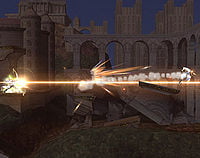Semi-spike: Difference between revisions
From SmashWiki, the Super Smash Bros. wiki
Jump to navigationJump to search
Luigifan18 (talk | contribs) m (Link-making) |
mNo edit summary |
||
| Line 1: | Line 1: | ||
{{ArticleIcons|ssb=y|ssbm=y|ssbb=y}} | {{ArticleIcons|ssb=y|ssbm=y|ssbb=y|ssb4=y}} | ||
[[Image:Semi-spike angles.png|thumb|The shaded angles considered to be semi-spikes.]] | [[Image:Semi-spike angles.png|thumb|The shaded angles considered to be semi-spikes.]] | ||
[[Image:Sheik Light Arrow.jpg|thumb|An example of a semi-spike; the opponent is sent at an angle that is almost parallel to the ground.]] | [[Image:Sheik Light Arrow.jpg|thumb|An example of a semi-spike; the opponent is sent at an angle that is almost parallel to the ground.]] | ||
Revision as of 17:49, October 28, 2015
A semi-spike or pseudo-spike is a type of attack that does not send the opponent directly downward, but instead in a mostly horizontal trajectory which (due to gravity) will quickly turn into a vertical trajectory. This is distinct from a meteor smash, which sends the enemy downwards without a prior horizontal trajectory. Semi-spikes are dangerous as they often leave targets below and away from the edge, one of the worst positions to recover from. When landing semi-spikes on inclines, there will usually be little to no audible reaction from the character or the audience due to the fact that, like a meteor smash/spike landing on a grounded opponent, the character being hit cannot travel at an angle due to the incline.

